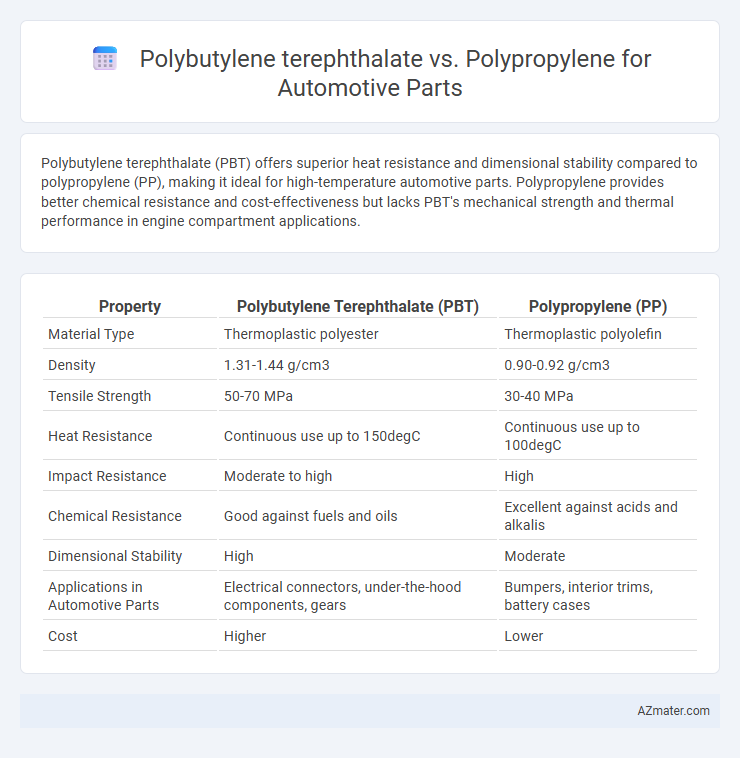Polybutylene terephthalate (PBT) offers superior heat resistance and dimensional stability compared to polypropylene (PP), making it ideal for high-temperature automotive parts. Polypropylene provides better chemical resistance and cost-effectiveness but lacks PBT's mechanical strength and thermal performance in engine compartment applications.
Table of Comparison
| Property | Polybutylene Terephthalate (PBT) | Polypropylene (PP) |
|---|---|---|
| Material Type | Thermoplastic polyester | Thermoplastic polyolefin |
| Density | 1.31-1.44 g/cm3 | 0.90-0.92 g/cm3 |
| Tensile Strength | 50-70 MPa | 30-40 MPa |
| Heat Resistance | Continuous use up to 150degC | Continuous use up to 100degC |
| Impact Resistance | Moderate to high | High |
| Chemical Resistance | Good against fuels and oils | Excellent against acids and alkalis |
| Dimensional Stability | High | Moderate |
| Applications in Automotive Parts | Electrical connectors, under-the-hood components, gears | Bumpers, interior trims, battery cases |
| Cost | Higher | Lower |
Introduction to Polybutylene Terephthalate and Polypropylene
Polybutylene terephthalate (PBT) is a thermoplastic engineering polymer known for its high strength, excellent electrical insulation properties, and resistance to heat and chemicals, making it ideal for automotive parts such as connectors, housings, and under-the-hood components. Polypropylene (PP) is a versatile thermoplastic polymer characterized by its lightweight, good fatigue resistance, and chemical inertness, commonly used in automotive applications like bumpers, interior trims, and battery cases. Both materials offer distinct mechanical and thermal properties, influencing their selection based on specific automotive application requirements.
Chemical Structure and Properties Comparison
Polybutylene terephthalate (PBT) features a semi-crystalline polyester structure with repeating ester groups, providing high mechanical strength, excellent thermal resistance up to 150degC, and superior dimensional stability compared to polypropylene (PP), which is a hydrocarbon-based polyolefin with a simpler polypropylene chain. PBT exhibits better chemical resistance against oils, fuels, and solvents, making it more suitable for automotive engine components exposed to harsh chemicals, whereas polypropylene offers higher impact resistance and lower density, benefiting applications where lightweight and flexibility are prioritized. The polar ester groups in PBT enhance its adhesion and compatibility with fillers and additives, contributing to improved thermal and electrical properties relative to the non-polar, hydrocarbon backbone of polypropylene.
Mechanical Strength and Durability
Polybutylene terephthalate (PBT) offers superior mechanical strength and thermal stability compared to polypropylene (PP), making it more suitable for automotive parts exposed to high stress and elevated temperatures. PBT's high tensile strength, excellent impact resistance, and resistance to fatigue enhance long-term durability in engine components and electrical connectors. Polypropylene, while lightweight and cost-effective, typically underperforms PBT in mechanical rigidity and thermal endurance, limiting its use in critical automotive applications demanding robust performance.
Thermal Stability and Heat Resistance
Polybutylene terephthalate (PBT) offers superior thermal stability and heat resistance compared to polypropylene (PP), with a melting point around 223degC versus polypropylene's melting point near 160degC. PBT maintains mechanical properties at elevated temperatures, making it ideal for automotive parts exposed to engine heat and under-the-hood environments. Polypropylene's lower heat resistance limits its use to less thermally demanding automotive components where flexibility and cost-effectiveness are prioritized.
Weight and Density Considerations
Polybutylene terephthalate (PBT) offers a density of approximately 1.31 g/cm3, providing moderate weight but superior stiffness and thermal stability compared to polypropylene (PP), which has a lower density of around 0.90-0.92 g/cm3, making it inherently lighter. The reduced weight of polypropylene makes it ideal for applications where minimizing mass is critical for fuel efficiency and handling, whereas PBT's higher density supports parts requiring enhanced mechanical strength and dimensional stability. Selecting between PBT and PP for automotive components depends on balancing the trade-offs between weight savings and performance requirements related to density-driven properties.
Resistance to Chemicals and Moisture
Polybutylene terephthalate (PBT) exhibits superior resistance to automotive chemicals such as oils, fuels, and coolants compared to polypropylene (PP), making it highly suitable for engine components and under-the-hood applications. PBT's low moisture absorption enhances dimensional stability and maintains mechanical properties in humid or wet environments, whereas polypropylene tends to absorb more moisture, risking swelling and degradation over time. These characteristics position PBT as the preferred choice for automotive parts requiring long-term exposure to harsh chemical and moist conditions.
Processing Methods and Manufacturing Efficiency
Polybutylene terephthalate (PBT) offers superior dimensional stability and resistance to heat, making injection molding the preferred processing method for automotive parts requiring complex geometries and high precision. Polypropylene (PP) excels in cost-effective manufacturing through techniques like extrusion and injection molding, benefiting from faster cycle times and lower energy consumption. Manufacturing efficiency in automotive applications favors PBT for high-performance components, while PP provides advantages in large-volume production due to its lower material and processing costs.
Cost Comparison for Automotive Applications
Polybutylene terephthalate (PBT) tends to have a higher raw material cost than polypropylene (PP), impacting the overall expense of automotive parts manufacturing. Despite the increased cost, PBT offers superior mechanical strength, thermal resistance, and dimensional stability, which can reduce long-term maintenance and replacement expenses in automotive applications. Polypropylene provides a more cost-effective solution with adequate durability for less demanding parts, making it ideal for budget-sensitive automotive component production.
Typical Automotive Parts for Each Polymer
Polybutylene terephthalate (PBT) is commonly used in automotive parts such as electrical connectors, sensor housings, and under-the-hood components due to its excellent dimensional stability, chemical resistance, and high heat tolerance. Polypropylene (PP) is typically found in interior trim panels, bumper fascias, and battery cases, valued for its impact resistance, lightweight nature, and cost-effectiveness. Each polymer's unique mechanical and thermal properties dictate its specific applications within automotive manufacturing, balancing performance and economic considerations.
Sustainability and Environmental Impact
Polybutylene terephthalate (PBT) offers superior durability and heat resistance compared to polypropylene (PP), making it ideal for automotive parts requiring long lifespan and thermal stability. PBT's enhanced recyclability and potential for bio-based variants contribute to reducing carbon footprint and environmental impact in automotive manufacturing. Polypropylene's lower weight supports fuel efficiency, but its environmental benefits are limited by lower mechanical performance and challenges in recycling mixed-polymer automotive components.

Infographic: Polybutylene terephthalate vs Polypropylene for Automotive Part
 azmater.com
azmater.com